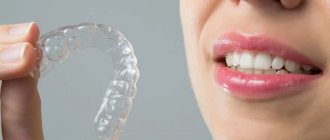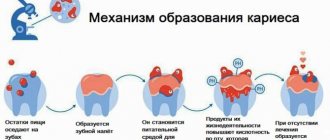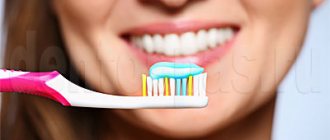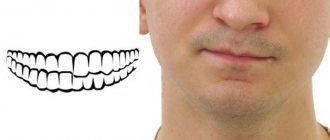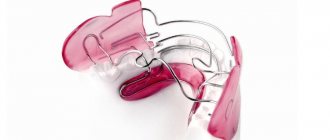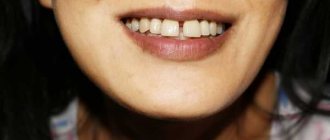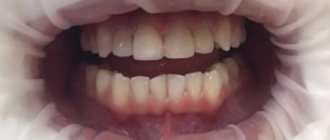Article navigation: Causes of the inflammatory process What are braces Types of braces by material Types of braces by location Braces by fixation method How to choose a brace system Prices for braces at INTAN Before/after photos
In modern dentistry, orthodontic fixed ones are widely used to correct dentition and malocclusion pathologies designs - braces (from the English bracket - “bracket”), fixed to the tooth enamel using special composite materials.
Varieties
Based on the type of bracket systems, a distinction is made between ligature and self-ligating systems. The former are fastened using devices - ligatures made of metal or elastic material. To fix the arch on self-ligating braces, there are latches, latches or spring clips. They are larger in size, but they are also easier to care for due to the absence of ligatures.
What it is?
Braces are essentially just that part of the bracket system that is attached to the tooth, a bracket for attaching a steel arch (wire). In addition to auxiliary fittings (springs, ligatures, rings) for fixing and tensioning the wire, a bracket system is formed.
The sooner you see an orthodontist, the better, but there is no age limit for use.
The essence of braces is to correct bite defects that lead to wear and destruction of tooth enamel, the appearance of caries and a decrease in aesthetic perception:
- protruding lower or upper jaw,
- uneven overlap,
- curvature of the dentition.
Installation location
Depending on the place of installation, braces are divided into vestibular and lingual. Classic vestibular appliances are attached to the outside of the dentition. Lingual braces are relatively new and are the latest word in orthodontics. They are installed on the inside of the teeth, they are practically invisible, which is why they are often called “invisible”. This is the best option from an aesthetic point of view. However, while wearing standard lingual braces, they can cause discomfort and affect diction. Individual systems are manufactured specifically for each patient. They are less uncomfortable, but also cause inconvenience.
Indications for use
Orthodontists consider braces to be the most effective method of eliminating a number of deficiencies - gaps between teeth and unfolded (twisted) units of the dentition. For example, in children, with the help of braces, various maxillofacial defects can be corrected, including:
- malocclusion of any variety (deep, distal, mesial, open, cross);
- abnormal width of the palate (both larger and smaller);
- abnormal speed of development of the upper or lower jaw (faster or slower than necessary);
- incorrect position of teeth;
- a gap between the front incisors, spaces or gaps between many or several units of the dentition.
This list concerns correction in children. For adults, the circumstances are different. Their jaw is already formed in a certain way; it is impossible to change its size. In adulthood, in the maxillofacial zone it is possible to:
- correct only some types of malocclusion;
- reduce the distance between teeth (usually concerns the smile area).
Material of manufacture
Different types of braces look different on your teeth. Sapphire ones are the most beautiful, made from artificial sapphire, they are associated more with jewelry than with orthodontic appliances. Ceramic ones also look good. Unlike sapphire, they have a more matte shade to best match the color of the patient's teeth. However, due to the yellowish tint, they are not as beautiful as sapphire systems.
- Metal
- Plastic
- Ceramic
- Sapphire
- Combined
The most common and most reliable devices. This is the most affordable type of dental braces. Installing them won't put a big dent in your budget, but such systems do not look attractive. However, now a compromise solution has been found in orthodontics - metal braces made of steel or alloys with a Teflon coating, which gives the structures a white tint, making them less conspicuous. It is important to understand that this coating wears off over time, and by the end of treatment, the braces look like regular metal ones.
These are vestibular systems made of medical hypoallergenic plastic. Braces and locks are selected exactly to match the color of the patient’s teeth, so they are not very noticeable from the outside. In order to make plastic braces more reliable, some manufacturers experiment with the composition of the material, while others use a special substrate between the tooth and the bracket that follows the anatomical shape of the tooth surface. However, these measures do not always prevent breakdowns. In recent years, wear of such braces has been noticed due to the low strength of this material. During the process of eating, the brace changes its shape, which slows down the patient’s treatment.
Dental ceramics are used to make these vestibular structures. In appearance, it is no different from natural tooth enamel, so ceramic braces are not too noticeable.
Another vestibular system with high aesthetic characteristics. Artificial sapphires are used to make it. They are transparent and shimmer beautifully in certain lighting. Sapphire braces are ideal for those who are sensitive to their appearance, as they look like an exquisite accessory.
These are vestibular devices made of several materials. Ceramics or sapphires are used in the smile area, and metal in the chewing area. Locks on the side teeth are invisible to others, so they can even be made of dark metal. In addition, this option helps to significantly save on treatment.
Pros and cons of different types of braces
As you can see, different types of dental braces have their own advantages and disadvantages.
Metal
- Low cost.
- Reliability.
- Guaranteed efficiency.
- Lack of aesthetics.
- Risk of irritation and tissue injury.
Plastic
- Low cost.
- Aesthetics.
- Fragility.
- Unreliability.
Ceramic
- High level of aesthetics.
- Reasonable price for aesthetic braces.
- Relative fragility.
- Yellowish matte shade.
- Irritation of the mucous membranes of the oral cavity due to relatively sharp angles.
Sapphire
- Aesthetics.
- Transparency.
- Relatively high price.
- Strength is lower than that of metal.
- Irritation of the mucous membranes of the oral cavity due to relatively sharp angles. .
Lingual
- Invisible to others.
- Reliability.
- High price of devices.
- High cost of installation and maintenance.
- Irritation of the mucous membranes of the mouth and tongue.
Combined
- Affordable price.
- Aesthetics.
- Reliability.
- Metal elements are noticeable with a wide smile.
- Difficult system maintenance.
How to put braces on teeth
Installing braces on teeth begins with an initial examination and a cast of the jaw. The doctor completely sanitizes the oral cavity, removes tartar and plaque. At this time, the master makes brackets based on an impression of the jaw, and then the orthodontist puts the structure on the teeth. In the future, you will need to visit the orthodontist for examination and adjustment of the structure.
Contraindications:
- oral infections;
- periodontal pathology;
- many filled teeth;
- enamel pathology;
- serious diseases of internal organs;
- pregnancy/lactation;
- HIV infection.
Advanced caries does not allow the installation of braces on the teeth, so first it is necessary to completely eliminate putrefactive processes in the oral cavity. Inflammatory processes in the mucous membrane are also an obstacle to the installation of orthodontic structures - first it is necessary to completely stop the pathology.
If a person is not used to taking care of their teeth, wearing braces can lead to various problems. Steel elements on the teeth lead to a rapid accumulation of bacteria that violate the integrity of the enamel - this is hello to caries.
Irregular cleansing of the oral cavity will provoke inflammatory processes on the mucous membranes.
There is also an absolute ban on installing braces:
- mental personality disorders;
- epilepsy, seizures;
- pathology of blood clotting;
- partial or complete edentia;
- oncological diseases;
- addiction to drugs/alcohol.
Also, staples are not placed on patients with tuberculosis and diabetes.
The first time after installation, you will feel severe discomfort in your mouth - pain when chewing food or touching your teeth. After some time, the discomfort will disappear, however, after adjusting the design by the orthodontist, it may reappear for a while.
What type of braces is best?
All braces are the same in terms of effectiveness. Therefore, when choosing a system, you must be guided by your own budget, aesthetic requirements and quality characteristics. The least expensive and most proven option is metal braces. The prices for plastic braces are also low, but in terms of strength, these structures are significantly inferior to metal ones. If aesthetics are most important to you, then it is better to give preference to ceramic or sapphire vestibular systems, as well as lingual braces, which will cost more than others. However, we should not forget that choosing a corrective system should be done after a preliminary consultation with an orthodontist.
Make an appointment
right now!
Astashkina Margarita Dmitrievna
Orthodontist
Rules of care
Because braces trap food particles during chewing, careful oral hygiene is necessary. At the appointment, the orthodontist explains in detail how to clean the teeth when wearing appliances.
Some rules:
- use a special brush for cleaning;
- clean your teeth with an irrigator;
- rinse your mouth every time after eating and even a light snack;
- preventively disinfect the oral cavity with medicinal balms and herbal infusions.
During dental correction, it is prohibited to use chewing gum or eat sticky candies such as “Iris” and lollipops. You'll have to give up chips and crackers.
Herbal rinse
To prevent inflammatory processes in the gums, you need to regularly rinse your mouth with herbal infusions or medicinal balms. Good herbal remedies to help prevent and eliminate inflammation include:
- aloe vera;
- echinacea;
- calendula;
- eucalyptus;
- goldenseal.
Herbs soothe irritated mucous membranes and stimulate local immunity. Echinacea is especially indicative in this case. For a pleasant aroma and fresh breath, use mint tincture or mint tea.
If pain appears in the mouth, the herbs sage, chamomile and St. John's wort will help relieve inflammation. For gum pathology, tea tree essential oil is used - applications, massage.
Rinse with antiseptics
Among pharmaceutical products are drugs with antibacterial and antiseptic properties. These include:
- furatsilin;
- miramistin;
- chlorhexidine.
However, long-term use of chlorhexidine causes the enamel to turn yellowish, so it is necessary to alternate the products with each other.
Home remedies for caring for mucous membranes and teeth include a soda solution. It is enough to dilute a coffee spoon in a cup of warm water.
You should rinse with an antiseptic solution after every snack - this is prevention. If inflammation occurs, rinse is used every 1.5-2 hours. Braces can negatively affect the condition of the mucous membrane, so if discomfort occurs, go to the dentist immediately.
Herbs not only effectively remove plaque on enamel, but also fight bacteria and strengthen local immunity. It is advisable to prepare herbal infusions daily, and not use yesterday’s or the day before yesterday’s.
Types and prices of bracket systems
Typically, prices for different types of braces vary, mainly depending on the type of orthodontic device, the material it is made of, and the category of the dental clinic. Thus, in premium dentistry you are unlikely to see the installation of metal or plastic systems in the list of services. On the other hand, lingual systems will be rare in economy class clinics.
| Type of braces | Clinic category | ||
Economy | Business | Premium | |
| Metal | from 50,000 rub. | from 80,000 rub. | – |
| Plastic | from 100,000 rub. | from 120,000 rub. | – |
| Ceramic | from 80,000 rub. | from 100,000 rub. | from 150,000 rub. |
| Sapphire | from 100,000 rub. | from 150,000 rub. | from 200,000 rub. |
| Lingual | from 180,000 rub. | from 230,000 rub. | from 250,000 rub. |
| Combined | from 90,000 rub. | from 130,000 rub. | from 150,000 rub. |
Whatever type of braces you choose, your orthodontic treatment will be equally effective. However, keep its timing in mind when choosing a sapphire system. And also about possible inconveniences in wearing if your choice is on lingual devices.
Publisher: Expert magazine about dentistry Startsmile.ru
